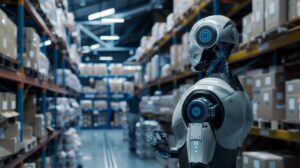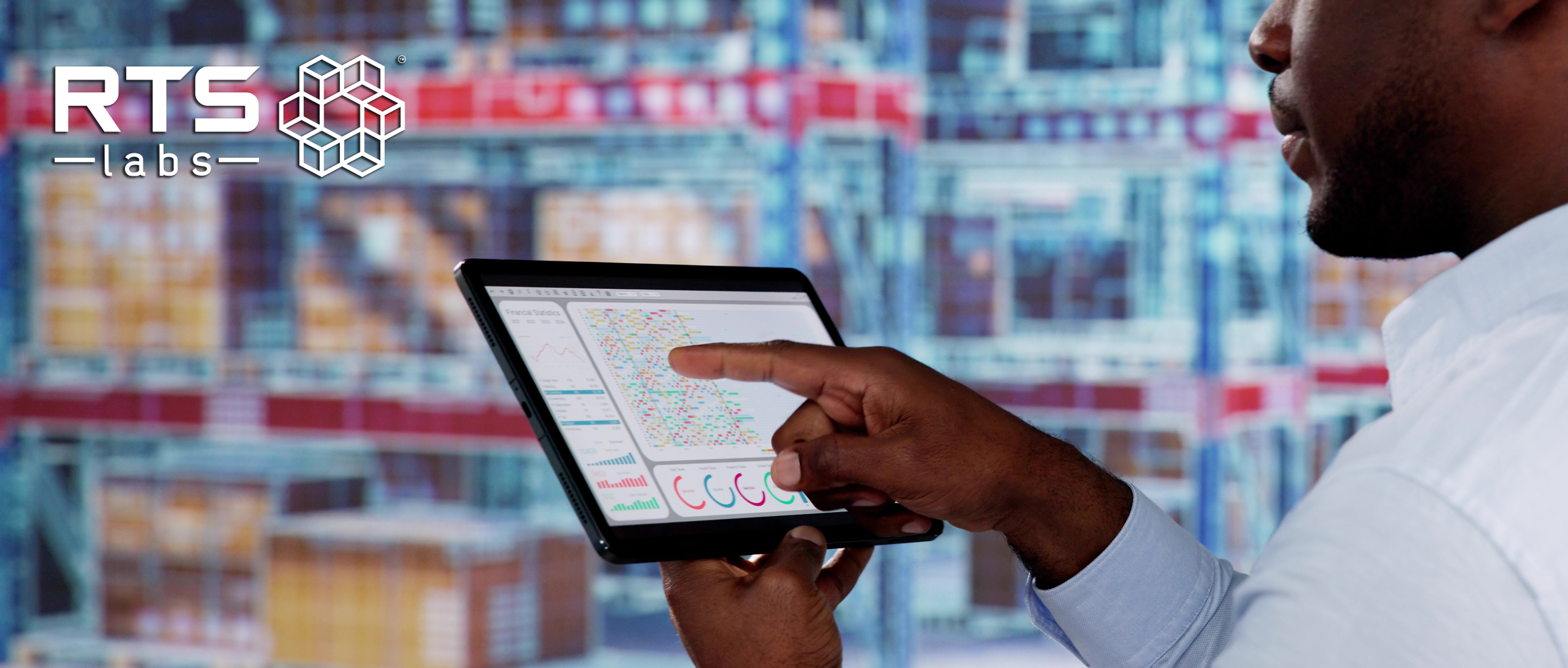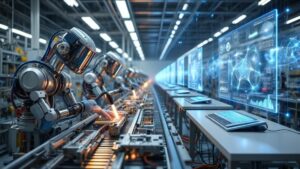Artificial Intelligence (AI) is transforming logistics, bringing precision, efficiency, and innovation to an industry that thrives on optimization. As more organizations implement AI, they see significant improvements in cost management, inventory accuracy, and service delivery. In fact, according to recent research by McKinsey, incorporating AI into logistics could lower operating costs by up to 15%, improve inventory management by 35%, and increase service levels by 65%. These improvements demonstrate AI’s increasing impact on all logistics tasks, from warehousing to delivery. Here are some of the most important logistics AI use cases and applications in 2024.
1. Demand Forecasting
Fluctuations in demand present a significant challenge for logistics planning. However, AI-driven forecasting, powered by machine learning algorithms, offers a great solution by analyzing vast amounts of data across the supply chain. This approach can predict demand with up to 50% less error compared to traditional statistical methods.
Examples of AI-Driven Success:
- PepsiCo: Achieved a 10% increase in forecast accuracy by leveraging AI to analyze point-of-sale (POS), inventory, and shipment data.
- Unilever: Enhanced forecast precision by an impressive 75% through AI-powered analytics.
- Coca-Cola: Reduced inventory buffer stock by 10-20%, thanks to the improved reliability of AI-generated forecasts.
These more accurate demand signals generated by AI enable logistics companies to optimize critical aspects such as capacity planning, inventory management, workforce scheduling, and transportation management. By doing so, they can improve service levels while simultaneously cutting operational costs, driving greater efficiency across the supply chain.
2. Dynamic Pricing
Dynamic pricing has emerged as an essential approach within the logistics sector, given the rapid shifts in market conditions due to factors such as fluctuating fuel prices, changing customer demand, and competitor movements. Adapting pricing strategies in response to these variables can significantly impact a company’s ability to remain competitive and maintain profitability.
Artificial intelligence has enhanced this approach by continuously analyzing a wide range of real-time data, including competitor rates, market needs, and customer behaviors. This constant assessment allows logistics companies to adjust their pricing models in real time, ensuring that they can respond to market changes swiftly while safeguarding their profit margins.
Moreover, integrating AI in pricing decisions facilitates a more nuanced approach. By considering a broader set of data points, businesses can implement more refined pricing strategies that take into account not just immediate market conditions but also long-term trends. This helps create pricing models that are not only reactive but also predictive, providing a strategic advantage in a highly competitive landscape.

3. Predictive Maintenance
Imagine AI as an expert mechanic anticipating when a machine might fail. It monitors data from sensors, such as temperature and vibrations, and compares it with historical trends. If something seems off, the AI signals that a component might need attention soon.
Translating this concept to the IT industry, AI performs a similar role. If a server begins to lag or there’s an unusual spike in network activity, AI can alert the IT team to potential problems. This early warning allows for timely interventions, such as upgrading hardware or enhancing security measures, to prevent system crashes or data breaches.
Proactive maintenance powered by AI helps ensure that websites and applications remain operational, data stays protected, and costly downtimes are minimized.
Here are some examples of corporations utilizing AI for predictive maintenance:
- Siemens: Siemens leverages AI for predictive maintenance of their industrial machinery, which has led to a significant reduction in unexpected failures and maintenance costs.
- General Electric (GE): GE uses AI to monitor jet engines, allowing them to predict maintenance needs before issues arise. This approach improves reliability and safety.
- Shell: Shell applies AI for predictive maintenance in their oil and gas operations, which has decreased downtime and boosted operational efficiency.
4. Warehouse Operations
Warehousing is at the core of logistics operations, and AI-powered robots are changing the way warehouses operate. Traditional warehouse operations often depend on physical labor, which is time-consuming, error-prone, and restricted in human capability.
AI-powered robots, on the other hand, can operate around the clock with precision and consistency. They power an extensive range of warehouse automation capabilities:
- Robotic Picking and Putaway: Companies such as Berkshire Grey and Covariant are transforming warehouse operations with AI-driven robotics that autonomously handle picking and placing tasks.
- Inventory Tracking: Solutions like Trax utilize computer vision to monitor inventory in real-time, providing accurate location data and instantly alerting staff about missing items.
- Workforce Management: Tools like Quinyx leverage AI to analyze demand forecasts and worker availability, allowing for the creation of optimized staffing schedules.
These innovations not only enhance productivity and accuracy but also improve safety and reduce operating costs. For instance, in trials conducted by Fast Radius and Covariant, AI led to a 130% improvement in picking productivity, increased inventory accuracy to 99.9%, and reduced warehouse workforce requirements by 80%.
Related Read: AI in Warehouse Management

5. Supply Chain Visibility
AI technologies have significantly enhanced visibility across supply chains by offering detailed, up-to-the-minute updates. These updates create a clearer view of operations, helping to improve communication among all parties involved. As a result, businesses can make better decisions and respond more quickly to any issues or changes that arise.
One notable example is IBM‘s Food Trust platform, which uses a combination of AI and blockchain technology to monitor the food supply chain. By tracking products from farm to table, this system ensures that food safety and quality are maintained, which is crucial for retailers and consumers. The technology’s ability to provide real-time data enables companies to identify and address potential problems before they escalate, thus minimizing risks.
Moreover, the increased transparency offered by AI-driven solutions helps build trust among supply chain partners. When all participants have access to the same reliable information, it reduces the chances of errors and discrepancies. This shared visibility offers more efficient collaboration, as everyone works with the same data, leading to smoother operations and a more resilient supply chain.
6. Route Optimization
AI-based route planning has revolutionized how logistics companies manage their delivery operations by analyzing a wide array of factors, such as traffic flow, road conditions, and vehicle load. By assessing these variables, companies can determine the most efficient paths for their fleets, which helps reduce travel distances, lower fuel consumption, and reduce the need for a large number of vehicles.
Real-time monitoring and forecasting techniques have improved how companies maintain their fleets. By monitoring vehicle performance and predicting potential issues before they arise, businesses can schedule maintenance at optimal times, preventing unexpected breakdowns. For example, P&O Ferrymasters has seen a notable improvement in cargo capacity, achieving a 10% increase by optimizing their vessel loading procedures using AI. Similarly, FedEx has substantially improved its delivery efficiency, trimming 700,000 miles off its daily routes through advanced planning methods.
The ability of AI to adapt to changing conditions on the fly adds another layer of efficiency. As traffic patterns shift throughout the day, AI systems can dynamically adjust routes to avoid delays, ensuring deliveries are made on time. This adaptability is particularly valuable in urban areas where congestion is unpredictable and can significantly impact delivery schedules.
7. Autonomous Vehicles
Autonomous trucks powered by AI have the potential to change the logistics industry completely. Although still in the early stages, autonomous driving is expected to generate between $300 billion to $400 billion in revenue by 2035.
Companies such as Waymo, TuSimple, and Embark are leading the way in testing driverless trucks. Equipped with Lidar, radar, cameras, and advanced machine learning algorithms, these vehicles can navigate and understand their surroundings without human input.
The impact of autonomous trucks on logistics could be huge. They could potentially reduce costs by 30-50% and enable round-the-clock operations.
While human drivers may still be needed in the near term, autonomous technologies are already being integrated to improve safety, fuel efficiency, and overall operational effectiveness.
8. Inventory Optimization
AI’s demand forecasting abilities are crucial for optimizing inventory turnover and minimizing stockouts. They allow retailers and manufacturers to better understand the seasonal patterns of their stock-keeping units.
For example, Gaviota, a company specializing in automated sun protection and shutters, implemented ToolsGroup’s SO99+ solution. This led to a 43% reduction in stock levels, decreasing inventory from 61 days to 35 days.
AI enhances this process by reading barcodes, text, and other information from images and cross-referencing it with the warehouse management system (WMS). This integration provides warehouse managers with real-time inventory updates through a dashboard, streamlining inventory management.

9. Logistics Network Design
Improving the design of logistics networks requires a deep analysis of multiple factors, including the placement of warehouses, the selection of transport routes, and the timing of deliveries. AI has brought a new level of sophistication to this process by examining vast amounts of data to determine the best possible network layouts. Through this method, companies can guarantee that their logistics operations run smoothly and cost-effectively.
For example, an AI system might suggest moving a warehouse closer to a major customer base to speed up deliveries and cut transportation costs. These systems can run countless simulations to test different scenarios, helping businesses understand the potential impact of various network adjustments before implementation. This predictive capability allows for smarter decision-making, ultimately leading to a more responsive and efficient logistics network.
In addition, AI-driven analysis provides insights that go beyond just the immediate benefits of cost and time savings. By considering a wide range of variables, including changes in customer demand and potential disruptions in supply chains, these systems help businesses create networks that are not only efficient but also resilient. Companies can better withstand unforeseen challenges, ensuring consistent service levels even under difficult conditions.
10. Risk Management
AI-driven risk management plays a crucial role in enhancing security within the logistics sector by identifying and mitigating potential threats throughout the shipment process. These systems utilize sophisticated monitoring tools to closely monitor cargo so that any unusual activity is detected and addressed promptly. This proactive strategy helps safeguard goods from theft, damage, or unauthorized access, providing a higher level of security for shipments.
For example, Maersk, a leading global shipping enterprise, employs advanced AI-based systems to monitor its shipping data continuously. By analyzing patterns and identifying irregularities, these systems can flag potential security breaches early, allowing for immediate action. This approach strengthens the security framework and reduces the likelihood of incidents that could compromise cargo safety.
AI’s ability to analyze vast amounts of data in real time enables companies to stay ahead of potential threats by recognizing patterns that human oversight might miss. This includes monitoring environmental factors, tracking shipment routes, and assessing the integrity of cargo containers. By predicting and responding to these risks before they escalate, businesses can avoid costly disruptions and ensure the smooth transit of goods.
AI-Driven Logistics: Shaping the Future of Efficiency and Resilience
The integration of AI into logistics is not just enhancing efficiency but also redefining operational standards across the industry. The examples discussed highlight how global leaders are utilizing these technologies to achieve remarkable accuracy, productivity, and overall service quality improvements.
AI is playing a pivotal role in enabling smarter warehouse operations, refining supply chain visibility, and optimizing routes for timely deliveries. As logistics networks become more complex, the use of AI provides companies with the tools they need to design strong networks, manage risks effectively, and maintain resilient operations.
If you want to bring these AI advancements into your logistics operations, RTS Labs offers expert services to help you implement these cutting-edge technologies tailored to your specific needs. Visit RTS Labs to learn how we can help you stay competitive and efficient in this rapidly advancing field.
FAQ: AI in Logistics
Q1: How is AI improving efficiency in logistics?
A1: AI enhances efficiency in logistics by optimizing various operations such as demand forecasting, dynamic pricing, route optimization, and warehouse management. By analyzing vast amounts of data in real time, AI enables more accurate decision-making, reduces operational costs, and improves service levels across the supply chain.
Q2: What are some real-world examples of AI in logistics?
A2: Companies like PepsiCo, Siemens, and FedEx are already leveraging AI in logistics. PepsiCo uses AI for demand forecasting, improving accuracy by 10%. Siemens utilizes AI for predictive maintenance, reducing unexpected failures, while FedEx has optimized delivery routes, saving 700,000 miles per day.
Q3: How does AI impact supply chain visibility?
A3: AI enhances supply chain visibility by providing real-time updates and insights into various operations. This leads to improved communication, quicker decision-making, and the ability to address potential issues before they escalate, resulting in a more resilient and efficient supply chain.
Q4: What is the role of AI in autonomous vehicles for logistics?
A4: AI is critical in developing autonomous vehicles, which have the potential to transform logistics by reducing costs and enabling continuous operations. Though still in early stages, AI-powered autonomous trucks from companies like Waymo and TuSimple are paving the way for the future of logistics.
Q5: Can small businesses benefit from AI in logistics?
A5: Absolutely. AI solutions can be scaled to fit businesses of all sizes. Small businesses can leverage AI for tasks like inventory optimization, dynamic pricing, and demand forecasting to improve efficiency, reduce costs, and stay competitive in the logistics industry.
Further Reading
“Prediction Machines: The Simple Economics of Artificial Intelligence” by Ajay Agrawal, Joshua Gans, and Avi Goldfarb
- This book explains the economic principles behind AI and how it can be applied to optimize logistics and supply chains. It’s an essential read for understanding the decision-making improvements AI brings to these industries.
View on Amazon
“AI in Logistics and Supply Chain Management” edited by Robert N. Boute and Maxi Udenio
- This book provides an in-depth analysis of AI’s role in transforming logistics and supply chain operations, featuring various case studies and future trends.
Read more on SpringerLink
“The Fourth Industrial Revolution” by Klaus Schwab
- While this book covers a broad range of topics, it provides valuable insights into how AI and other technologies are impacting industries, including logistics and supply chain management.
View on Amazon
These resources will provide you with a deeper understanding of AI’s transformative role in logistics and supply chain management.






